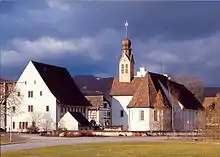Tänikon Abbey
Tänikon Abbey is a former Cistercian nunnery in the village of Ettenhausen in the municipality of Aadorf in the canton of Thurgau in Switzerland. The former abbey church and the conventual buildings, now Agrotechnorama Tänikon, are both Swiss heritage sites of national significance.[1]

History
Tänikon was first mentioned in 789 as Tanninchova as a local court. In 817 emperor Louis the Pious gave all his lands in Thurgau, including Tänikon, to the Abbey of St. Gall. An established nunnery at Tänikon was first mentioned in 1249. In 1257, the abbey church took over the rights to the nearby chapel of St. Anna. Around the same time Eberhard II and Eberhard III of Bichelsee granted land holdings to the abbey and it became Cistercian. In 1263, Pope Urban IV asked the abbot of Kappel to administer Tänikon. From 1268 the community had a number of lay brothers who lived and worked onsite. They were slowly replaced by secular servants or employees and by 1491 there were no more lay brothers. In 1415 the Hohenlandenberg and Gachnang families donated money to help establish a parish benefice for the chapel. By 1520, the abbey owned land or rights in Aadorf, Bichelsee, Elgg, Ellikon, Ettenhausen Gerlikon, Guntershausen, Hagenbuch, Krillberg, Lommis, Niederwil, Stettfurt, Tannegg and Tuttwil. In 1508 Abbess Anna Welter of Blidegg built a new refectory on the grounds.[2]
During the Protestant Reformation in 1523 several nuns left the abbey. When the Protestant Council of Zurich visited in 1525, there were still 13 nuns in residence. A few years later, in 1532, the abbess retired though a few sisters remained. Sophia von Grüth was appointed caretaker over the monastery in 1548. Two years later she was raised to be the abbess and the Abbot of Wettingen was appointed as the abbey's Visitor. It became a center of the Counter Reformation and in 1606 all nuns were required strictly to obey the rules of the order. During the 17th century, the community grew and several new buildings were built, including the prelate's house in 1616 and the abbess's house in 1678.
During the wave of secularization that followed the Helvetic Republic, much of the abbey's land was nationalized. After 1804, the community were virtually forbidden to accept any new novitiates. The Thurgau Cantonal Constitution of 1831 placed all the abbey's assets under state control. In 1836, the canton appointed a trustee and sold off the lands. In 1848 the Grand Council of Thurgau dissolved the abbey and took over the buildings. Two years later, 1850, they sold the nunnery and chapel to the Planta family and the Tänikon parish church. In 1853, the nuns moved into the former Capuchin friary at Frauenfeld. In 1869 they moved again to Mariastern Abbey in Vorarlberg in Austria. The premises were sold in 1936 to Otto Zuber and in 1969 were taken over by the new Eidgenossenschaft Forschungsanstalt für Betriebswirtschaft und Landtechnik (Swiss Federal Institute of Business and Agriculture), which in 2006 became the Agrotechnorama Tänikon.[2]
During the 15th and 16th centuries, parts of the abbey were demolished and later a road was built through the cloister. The former abbey church includes a marble pulpit and altar by Johann Josef Mosbrugger from 1830-31.[3]
List of the Abbesses
| Abbess[4] | Date in office |
|---|---|
| Hemma | until c. 1270 |
| Elisabeth | c. 1270 – 1285 |
| Guta von Bichelsee | 1285? – 1305 |
| Ite or Idda | 1305 – 1309 |
| Adelheid | 1309 – 1335 |
| Katharina Rinwin | 1335 – 1347 |
| Ita | 1347 – 1360? |
| Clara von Lindenberg | 1360? – 1371 |
| Ita von Schlatt | 1371 – 1380? |
| Clara von Gachnang | 1380? – 1387 |
| Elisabeth Rüdlinger | 1387 – 1398? |
| Anna von Gachnang | 1398? – 1415 |
| Katharina Schenk von Landegg | 1415 – 1430? |
| Anna Schlatter | 1430? – 1436 |
| Ursula von Eppenberg | 1436 – 1460? |
| Dorothea von Heudorf | 1460? – 1504 |
| Anna Wälter I. von Blidegg | 1504 – 1521? |
| Amalia Gnäpser | 1521? – 1524 |
| Anna Wälter II. von Blidegg | 1524 – 1532 |
| Sophia von Grüt | 1548 – 1579 |
| Barbara von Hertenstein | 1579 – 1608 |
| Veronika von Grüt | 1608 – 1617 |
| Anna von Wellenberg | 1617 – 1623 |
| Magdalena Hoppler | 1623 – 1639 |
| Marie Salome Schmid | 1639 – 1677 |
| Maria Victoria von Beroldingen | 1677 – 1687 |
| Maria Elisabeth Dietrich | 1687 – 1707 |
| Maria Euphemia Zurlauben | 1707 – 1737 |
| Euphemia Dorothea Ceberg | 1737 – 1762 |
| Maria Barbara Rüti | 1762 – 1773 |
| Maria Katharina Weiss | 1773 – 1796 |
| Dominika Agatha Seiler | 1796 – 1827 |
| Maria Johanna Baptista Rutz | 1827 – 1848 |
Agrotechnorama Tänikon
The Agrotechnorama Tänikon is a museum dedicated to the development of agricultural technology in the 19th and 20th centuries. The museum occupies the 1,800 m2 (19,000 sq ft) former abbey barn and includes about 750 objects from 1813 to 1984 showing the transition from manual labor to animal powered and mechanized farming. The museum is open by appointment only.[5]
References
- "Kantonsliste A-Objekte: Thurgau" (PDF). KGS Inventar (in German). Federal Office of Civil Protection. 2009. Archived from the original (PDF) on 18 July 2011. Retrieved 28 November 2009.
- Tänikon in German, French and Italian in the online Historical Dictionary of Switzerland.
- Flüeler (1982). Kulturführer Schweiz. Zurich, CH: Ex Libris Verlag AG. p. 28.
- Zehnder, Herbert (1992). Tänikon. Katholische Kirchgemeinde Tänikon. pp. 20–35.
- "Agrotechnorama Tänikon". www.agroscope.admin.ch (in German). Retrieved 2018-01-31.